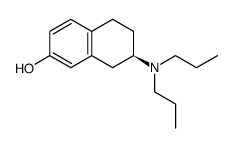Dopamine D3 receptor-preferring agonists increase dendrite arborization of mesencephalic dopaminergic neurons via extracellular signal-regulated kinase phosphorylation.
Ginetta Collo, Silvia Zanetti, Cristina Missale, Pierfranco Spano
Index: Eur. J. Neurosci. 28(7) , 1231-40, (2008)
Full Text: HTML
Abstract
Clinical improvements in Parkinson's disease produced by dopamine D3 receptor-preferring agonists have been related to their neuroprotective actions and, more recently, to their neuroregenerative properties. However, it is unclear whether dopamine agonists produce their neurotrophic effects by acting directly on receptors expressed by the mesencephalic dopaminergic neurons or indirectly on receptors expressed by astrocytes, via release of neurotrophic factors. In this study, we investigated the effects of the dopamine D3 receptor-preferring agonists quinpirole and 7-hydroxy-N,N-di-propyl-2-aminotetralin (7-OH-DPAT), as well as of the indirect agonist amphetamine, on dopaminergic neurons identified by tyrosine hydroxylase immunoreactivity (TH-IR). Experiments were performed on neuronal-enriched primary cultures containing less than 0.5% of astrocytes prepared from the mouse embryo mesencephalon. After 3 days of incubation, both quinpirole (1-10 microm) and 7-OH-DPAT (5-500 nm) dose-dependently increased the maximal dendrite length (P < 0.001), number of primary dendrites (P < 0.01) and [3H]dopamine uptake (P < 0.01) of TH-IR-positive mesencephalic neurons. Similar effects were observed with 10 microm amphetamine. All neurotrophic effects were blocked by the unselective D2/D3 receptor antagonist sulpiride (5 microm) and by the selective D3 receptor antagonist SB-277011-A at a low dose (50 nm). Quinpirole and 7-OH-DPAT also increased the phosphorylation of extracellular signal-regulated kinase (ERK) within minutes, an effect blocked by pretreatment with SB-277011-A. Inhibition of the D2/D3 receptor signalling pathway to ERK was obtained with PD98059, GF109203 or LY294002, resulting in blockade of neurotrophic effects. These data suggest that dopamine agonists increase dendritic arborizations of mesencephalic dopaminergic neurons via a direct effect on D2/D3 receptors, preferentially involving D3 receptor-dependent neurotransmission.
Related Compounds
| Structure | Name/CAS No. | Molecular Formula | Articles |
|---|---|---|---|
 |
R(+)-7-HYDROXY-2-DIPROPYLAMINO TETRALIN&
CAS:82730-72-1 |
C16H25NO |
|
Chemical genetics reveals a complex functional ground state ...
2007-05-01 [Nat. Chem. Biol. 3(5) , 268-273, (2007)] |
|
Genetic mapping of targets mediating differential chemical p...
2009-10-01 [Nat. Chem. Biol. 5 , 765-71, (2009)] |
|
Role of dopamine D2 and D3 receptors in mediating the U-50,4...
2012-11-01 [Addict. Biol. 17(6) , 949-55, (2012)] |
|
Stimulation of dopamine D2/D3 but not D1 receptors in the ce...
2010-12-25 [Behav. Brain Res. 214(2) , 386-94, (2010)] |
|
Role of the neurokinin-1 receptors in ejaculation in anesthe...
2009-01-01 [J. Sex. Med. 6(1) , 126-34, (2009)] |